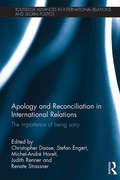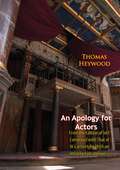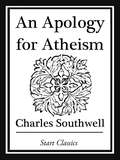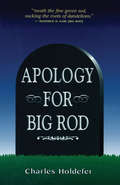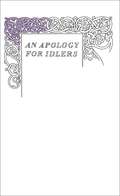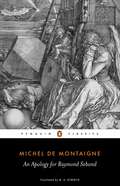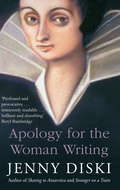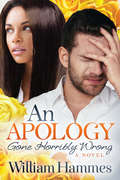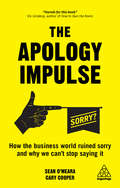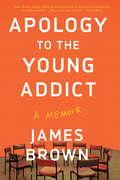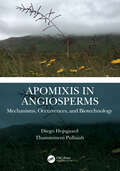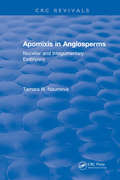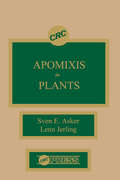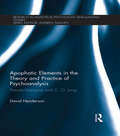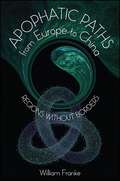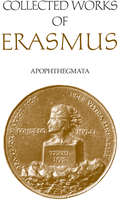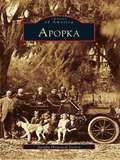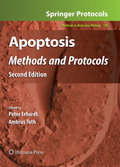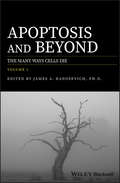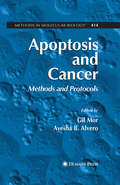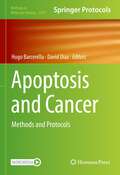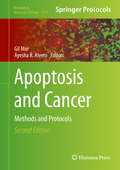- Table View
- List View
Apology and Reconciliation in International Relations: The Importance of Being Sorry (Routledge Advances in International Relations and Global Politics)
by Judith Renner Christopher Daase Stefan Engert Michel-André Horelt Renate StrassnerThis book looks into the role and effects of public apologies in international relations. It focuses on two major questions - why and when do states issue apologies for historic crimes and how and under what conditions are these apologies successful in remedying conflictive relationships? In recent years, we have witnessed an unseen popularity of apologies, with numerous politicians, managers and clergymen being eager to apologise and atone for the wrong-doings of their countries or institutions. Public apologies, thus, are a new and highly interesting, while nevertheless still puzzling phenomenon, the precise role and meaning of which in international politics remains to be explored. This book sets out to do exactly this. Focusing in particular on state apologies, it assembles twelve detailed empirical case studies which deal with the two questions raised above. In the first part, the case studies reconstruct the processes in which state representatives react to calls for public atonement, and in the second part the case studies explore the reactions to the apology and evaluate signs for its success or failure. All case studies are based on a theoretical framework which is outlined in the introduction to the book and helps develop tentative assumptions about the emergence and the effects of state apologies, drawing on different strands of literature, such as political science, philosophy, sociology or psychology. This work will be of great interest to students and scholars of conflict reconciliation, international relations and transitional justice.
An Apology for Actors: From the Edition of 1612, Compared with That of W. Cartwright. With an introduction and notes
by Thomas HeywoodHeywood is a good example of the professional dramatist who worked for Philip Henslowe, the theatrical manager, both as a playwright and an actor. By his own admission, Heywood claimed to have "either an entire hand or at least the main finger" in 220 plays, of which less than 30 survive. His best-known play, A Woman Killed with Kindness (1603), exemplifies domestic tragedy, in which sentiment and homely details are equally mingled. Heywood wrote an eloquent defense of the theater against Puritan attack called An Apology for Actors (1607-08). Heywood suggests here that the stage can both delight and teach.-Print ed.
An Apology for Atheism
by Charles SouthwellIt would be absurd to doubt that religion has an important bearing on all the relations and conditions of life. The connexion between religions faith and political practice is, in truth, far closer than is generally thought. Public opinion has not ripened into a knowledge that religious error is the intangible but real substratum of all political injustice. Though the 'schoolmaster' has done much, there still remain and hold some away among us, many honest and energetic assertors of 'the rights of man,' who have to learn that a people in the fetters of superstition, can never achieve political freedom. Many of these reformers admit the vast, the incalculable influence of Mahommedanism on the politics of Constantinople, and yet persist in acting as if Christianity had little or nothing to do with the politics of England.
Apology for Big Rod
by Charles HoldeferRod Gass is accused of being a criminal. He's failed at careers that people didn't know existed. Now a custodian at the Van Allen School of Mortuary Science, he is enjoying himself immensely. His niece, Judy, wants to know why. She is the only one ready to unveil this man, and to challenge him on his own terms. Rich in humor and with an acute sense of the absurdities of everyday life, Apology for Big Rod is an American success story of an altogether different sort.
An Apology for Idlers (Penguin Great Ideas)
by Robert Louis StevensonAn irresistible invitation to reject the work ethic and enjoy life's simple pleasures (such as laughing, drinking and lying in the open air), Robert Louis Stevenson's witty and seminal essay on the joys of idleness is accompanied here by his writings on, among other things, growing old, visiting unpleasant places and the overwhelming experience of falling in love. Throughout history, some books have changed the world. They have transformed the way we see ourselves - and each other. They have inspired debate, dissent, war and revolution. They have enlightened, outraged, provoked and comforted. They have enriched lives - and destroyed them. Now Penguin brings you the works of the great thinkers, pioneers, radicals and visionaries whose ideas shook civilization and helped make us who we are
An Apology for Raymond Sebond
by Michel MontaigneAn Apology for Raymond Sebond is widely regarded as the greatest of Montaigne's essays: a supremely eloquent expression of Christian scepticism. An empassioned defence of Sebond's fifteenth-century treatise on natural theology, it was inspired by the deep crisis of personal melancholy that followed the death of Montaigne's own father in 1568, and explores contemporary Christianity in prose that is witty and frequently damning. As he searches for the true meaning of faith, Montaigne is heavily critical of the arrogant tendency of mankind to create God in its own image, and offers his personal reflections on the true role of man, the need to eschew personal arrogance, and the vital importance of faith if we are to understand our place in the universe. Wise, perceptive and remarkably informed, this is one of the true masterpieces of the essay form.
An Apology for Raymond Sebond
by Michel De Montaigne M. A. ScreechIn his introduction, Screech writes: "Montaigne gives his readers the fruits of his own wide reading and of his own reflections upon it, all measured against his personal experience during a period of intellectual ferment and of religious and political disarray. Montaigne never let himself be limited by his office or station. As husband, father, counsellor, mayor, he kept a critical corner of himself to himself, from which he could judge in freedom and seek to be at peace with himself. He does not crush his reader under the authority of the great philosophers: he tries out their opinions and sees whether they work for him or for others. Traces of Plato, Aristotle, Plutarch, Cicero, St Augustine or of his own contemporaries can be found in every page he wrote, but they are skilfully interwoven into his own discourse, being renewed and humanized in the process. And he hardly ever names them. An Apology For Raymond Sebond has all these qualities, despite its being the longest piece Montaigne ever wrote. In it, Montaigne remains triumphantly himself."
Apology For The Woman Writing
by Jenny DiskiMarie de Gournay was eighteen when she read, and was overwhelmed by, the essays of the French philosopher Montaigne. She had to be revived with hellebore. When she finally met Montaigne, she stabbed herself with a hairpin until the blood ran in order to show her devotion. He made her his adopted daughter for the two months they knew each other. He died four years later, after which, though scorned by intellectuals, she became his editor. Jenny Diski engages with this passionate and confused relationship between 'father and daughter', old writer/young acolyte, possible lovers, using both their voices. Much of their story is about absence of the people they love. In Jenny Diski's hands it becomes a fascinating tale.
Apology For The Woman Writing
by Jenny DiskiMarie de Gournay was eighteen when she read, and was overwhelmed by, the essays of the French philosopher Montaigne. She had to be revived with hellebore. When she finally met Montaigne, she stabbed herself with a hairpin until the blood ran in order to show her devotion. He made her his adopted daughter for the two months they knew each other. He died four years later, after which, though scorned by intellectuals, she became his editor. Jenny Diski engages with this passionate and confused relationship between 'father and daughter', old writer/young acolyte, possible lovers, using both their voices. Much of their story is about absence of the people they love. In Jenny Diski's hands it becomes a fascinating tale.
An Apology Gone Horribly Wrong: A Novel
by William HammesAn Apology Gone Horribly Wrong is a romantic comedy set in the mid-1980s that explores deep wounds and the role trust plays in everyday life.When Sam Milton tries to apologize to the beautiful Chantell León, a top recording artist, for a minor traffic accident, the apology goes horribly wrong. Having already fumbled the apology once in the moment, Sam makes it worse by chasing Chantell down at Universal Studios, sending Chantell into a tirade on national TV, and pleading with her fans for protection. The situation continues to spin out of control as a vigilante mob goes looking for Sam. Within hours, Sam loses everything, including his house, finances and reputation.Fortunately, a friend of Sam&’s is able to get the two together in hopes of resolving the situation. To avoid a huge multimillion dollar lawsuit, Sam comes up with a plan to let Chantell reimburse everything she has taken from him by completing six simple tasks. Although each is simple in nature and starts out easy, each sequential task becomes more difficult and requires her to have more and more trust in someone she doesn&’t trust at all. As the pair moves through their journey, feelings develop, and they realize God is using them to vet out deep wounds. However, things don&’t go as planned and, soon, massive amounts of trust will be required of each. Can they learn to trust each other and heal their emotional wounds despite all they&’ve been through?
The Apology Impulse: How the Business World Ruined Sorry and Why We Can’t Stop Saying It
by Cary Cooper Sean O'MearaSaying sorry is in crisis. On one hand there are anxious PR aficionados and social media teams dishing out apologies with alarming frequency. On the other there are people and organizations who have done truly terrible things issuing much-delayed statements of mild regret. We have become addicted to apologies but immune from saying sorry. In January 2018 there were 35 public apologies from high-profile organizations and individuals. That's more than one per day. Between them, in 2017, the likes of Facebook, Mercedes Benz and United Airlines issued over 2,000 words of apologies for their transgressions. Alarmingly, the word 'sorry' didn't appear once. This perfectly timed book examines the psychology, motivations and even the economic rationale of giving an apology in the age of outrage culture and on-demand contrition. It reveals the tricks and techniques we all use to evade, reframe and divert from what we did and demonstrates how professionals do it best. Providing lessons for businesses and organizations, you'll find out how to give meaningful apologies and know when to say sorry, or not say it at all. The Apology Impulse is the perfect playbook for anyone - from social media executive through to online influencers and CEOs - who apologise way too much and say sorry far too infrequently.
Apology to the Young Addict: A Memoir
by James BrownHusband, addict, father, skeptic. Now sixty—with years of sobriety under his belt—the celebrated author of The Los Angeles Diaries and This River returns with his most moving work yet.Opening with the tragic tale of an elderly couple consumed by opioid addiction and moving through the horrors of a Las Vegas massacre to the loss of a beloved sponsor, these essays draw on Brown’s personal journey to illustrate how an individual life, in all its messiness and charm, can offer a blueprint for healing. From writing about finding a new path in life while raising three sons, to making peace with the family whose ghosts have haunted him, and helping the next generation of addicts overcome their disease, this haunting and hopeful book is a reinvention of the recovery story and a lasting testimony from the master of the modern memoir.“The third panel in Brown’s masterwork triptych on addiction from youth to sixty, Apology to the Young Addict also accomplishes at last a staggeringly rare mercy—on the ghosts of memory, the ravages of disease, the brutal hypocrisies of religion, and finally—most shockingly—on himself.” —Gina Frangello, author of Every Kind of Wanting and A Life in Men
Apomixis in Angiosperms: Mechanisms, Occurrences, and Biotechnology
by Diego Hojsgaard Thammineni PullaiahApomixis is a difficult-to-analyse trait with a complex molecular basis and a substantive effect on the biology of a species. Thus, apomixis is an interesting characteristic for researchers and students working in different fields of plant science and agriculture, and technological advances are enabling and making apomixis studies more common. Apomixis in Angiosperms: Mechanisms, Occurrences, and Biotechnology provides a systematic introduction to the mechanisms and developmental types of apomixis along with an overview of alternative methodologies for identifying apomixis and a detailed reassessment of the occurrences of apomictic species among angiosperm families. Optional methods are illustrated with examples of all types of apomixis and biological levels of analysis, i.e. cells, ovules, seeds and offspring. Data on apomictic species are collected in tables along with information on ploidy, type of apomixis and references. Occurrences of apomixis are briefly discussed in phylogenetic and evolutionary contexts. An outline of the molecular basis of apomixis in plants is presented, together with prospects and challenges that remain for its biotechnological exploitation. This book: Provides a systematic overview of the mechanisms of apomixis, developmental types and methodology for apomixis research. Reassesses apomixis at the species level in angiosperm families. Contains tables summarizing relevant information on apomixis. Analyses occurrences of apomixis in phylogenetic and evolutionary contexts. Outlines the molecular basis and biotechnological perspective of apomixis breeding. This book presents an accessible overview of apomixis research and a curated dataset of apomictic species. It serves as a reference book for students, researchers and citizen scientists interested in apomixis, as well as researchers, business innovators and entrepreneurs pursuing apomixis breeding. It can also be used as a textbook in graduate courses on plant reproduction. Diego Hojsgaard Taxonomy and Evolutionary Biology, Leibniz Institute of Plant Genetics and Crop Plant Research, Gatersleben, Germany, and Faculty of Exact, Chemical and Natural Sciences, National University of Misiones, Posadas, Argentina. Thammineni Pullaiah Department of Botany, Sri Krishnadevaraya University, Anantapur, India.
Apomixis in Angiosperms
by Tamara N. NaumovaApomixis in Angiosperms: Nucellar and Integumentary Embryony is based on original cytoembryological data and critically reviewed literature on more than 250 species from 57 families of angiosperms. The book covers the complete process of nucellar and integumentary embryo formation and viable seed development within species, families, and among angiosperms in general. Many species (some of which are economically important) characterized by adventive embryony are listed. The book also provides an original simple classification of apomixis and offers a new approach to differentiating embryological structures in cases of apomixis and amphimixis.Apomixis in Angiosperms: Nucellar and Integumentary Embryony will be a useful reference for embryologists, botanists, cytologists, geneticists, and plant breeders. It will also benefit any researcher interested in studying somatic embryo formation in tissue culture.
Apomixis in Plants
by Lenn JerlingApomixis in Plants presents a comprehensive review of different aspects of asexual seed formation in plants. This is important in plant research since apomixis could greatly facilitate breeding in important crops. It is also interesting theoretically because it carries problems related to genetic variation and evolution to its extreme.The book features a broad selection of topics, including a historical review of ideas and landmarks in the field; comparisons with other types of asexual reproduction in higher plants and with related phenomena in animals and related plants; a presentation of cytology and embryology of apomicts and the diversified terminology in the field; views on the genetic background of apomixis and environmental effects on its expression; and the interrelation between apomixis and other traits. Additional topics covered include classical and modern theories of sexual versus asexual reproduction; geographical and taxonomical trends in apomicts; ecological implications of apomixis, and a review of future possibilities for using apomixis in plant breeding. Apomixis in Plants is an important reference volume for researchers and students in all areas of botany, ecology, and plant breeding.
Apophatic Elements in the Theory and Practice of Psychoanalysis: Pseudo-Dionysius and C.G. Jung (Research In Analytical Psychology And Jungian Studies)
by David HendersonHow can the psychotherapist think about not knowing? Is psychoanalysis a contemplative practice? This book explores the possibility that there are resources in philosophy and theology which can help psychoanalysts and psychotherapists think more clearly about the unknown and the unknowable. The book applies the lens of apophasis to psychoanalysis,
Apophatic Paths from Europe to China: Regions without Borders (SUNY series in Chinese Philosophy and Culture)
by William FrankeIn Apophatic Paths from Europe to China, William Franke brings his original philosophy of the unsayable, previously developed from Western sources such as ancient Neoplatonism, medieval mysticism, and postmodern negative theology, into dialogue with Eastern traditions of thought. In particular, he compares the Daoist Way of Chinese wisdom with Western apophatic thought that likewise pivots on recognizing the nonexistent, the unthinkable, and the unsayable. Leveraging François Jullien's exegesis of the Chinese classics' challenge to rethink the very basis of life and consciousness, Franke proposes negative theology as an analogue to the Chinese model of thought, which has long been recognized for its special attunement to silence at the limits of language. Crucial to Franke's agenda is the endeavor to discern and renew the claim of universality, rethought and reconfigured within the predicament of philosophy today considered specifically as a cultural or, more exactly, intercultural predicament.
Apophthegmata
by Elaine Fantham Betty I. Knott-Sharpe Desiderius ErasmusAssembled for the young Prince William of Cleves, Erasmus' Apophthegmata consists of thousands of sayings and anecdotes collected from Greek and Latin literature for the moral education of the future ruler. Betty I. Knott and Elaine Fantham's annotated translation of the aphorisms and Erasmus' commentary on them makes this once popular literary and educational text accessible to modern audiences. The introduction discusses the origins of the Apophthegmata, the contents of the collection, and Erasmus' sources.
Apopka
by Apopka Historical SocietyApopka, Florida, started out as a place once dubbed "Big Potato" by the Native Americans of the area and was formerly known as the "Fern City," but it is now most notably considered the "Indoor Foliage Capitol of the World." Once-thriving fragrant citrus groves have been replaced by climate-controlled greenhouses and fields of landscaped nurseries and subdivisions. The second largest city in Orange County, Apopka is located in the northwest region of the county. It functions today as a bedroom community for Orlando and boasts the history of a community filled with a deep sense of pride.
Apoptosis: Methods and Protocols, Second Edition (Methods in Molecular Biology #559)
by P. Erhard Ambrus TothThe ability to detect and quantify apoptosis, to understand its biochemistry, and to identify its regulatory genes and proteins is crucial to biomedical research. In Apoptosis: Methods and Protocols, Second Edition, expert researchers describe the techniques to best investigate the critical steps involved in the apoptotic process. Presented from several different research perspectives, the volume contains sections covering detection of apoptosis, detection of non-apoptotic cell death, modifications of apoptotic proteins during apoptosis, the analysis of its major regulators, as well as analysis of apoptosis in different organs and in model organisms. Written in the highly successful Methods in Molecular BiologyTM series format, chapters include introductions to their respective topics, lists of the necessary materials and reagents, step-by-step, readily reproducible protocols, and notes on troubleshooting and avoiding known pitfalls. Comprehensive and cutting-edge, Apoptosis: Methods and Protocols, Second Edition constitutes a key technical reference to the significant methodologies used in the field, and offers beginners and experienced researchers powerful tools to illuminate the phenomena of programmed cell death.
Apoptosis
by Douglas R. Green John C. ReedApoptosis, or cell death, can be pathological, a sign of disease and damage, or physiological, a process essential for normal health. This book, with contributions from experts in the field, provides a timely compilation of reviews of mechanisms of apoptosis. The book is organized into three convenient sections. The first section explores the different processes of cell death and how they relate to one another. The second section focuses on organ-specific apoptosis-related diseases. The third section explores cell death in non-mammalian organisms, such as plants. This comprehensive text is a must-read for all researchers and scholars interested in apoptosis.
Apoptosis and Beyond: The Many Ways Cells Die
by James A. RadosevichThese volumes teach readers to think beyond apoptosis and describes all of the known processes that cells can undergo which result in cell death This two-volume source on how cells dies is the first, comprehensive collection to cover all of the known processes that cells undergo when they die. It is also the only one of its kind to compare these processes. It seeks to enlighten those in the field about these many processes and to stimulate their thinking at looking at these pathways when their research system does not show signs of activation of the classic apoptotic pathway. In addition, it links activities like the molecular biology of one process (eg. Necrosis) to another process (eg. apoptosis) and contrasts those that are close to each. Volume 1 of Apoptosis and Beyond: The Many Ways Cells Die begins with a general view of the cytoplasmic and nuclear features of apoptosis. It then goes on to offer chapters on targeting the cell death mechanism; microbial programmed cell death; autophagy; cell injury, adaptation, and necrosis; necroptosis; ferroptosis; anoikis; pyronecrosis; and more. Volume 2 covers such subjects as phenoptosis; pyroptosis; hematopoiesis and eryptosis; cyclophilin d-dependent necrosis; and the role of phospholipase in cell death. Covers all known processes that dying cells undergo Provides extensive coverage of a topic not fully covered before Offers chapters written by top researchers in the field Provides activities that link and contrast processes to each other Apoptosis and Beyond: The Many Ways Cells Die will appeal to students and researchers/clinicians in cell biology, molecular biology, oncology, and tumor biology.
Apoptosis and Cancer: Methods and Protocols (Methods in Molecular Biology #414)
by Ayesha Alvero Gil MorThe aim of Apoptosis and Cancer is to describe the performance of contemporary techniques for studying the biology of apoptosis and its role in cancer. The protocols described will aid both the academic laboratory interested in further characterizing the mechanisms of apoptosis, as well as the industry laboratory, aimed at identifying new target molecules or screening for new compounds with potential clinical use.
Apoptosis and Cancer: Methods and Protocols (Methods in Molecular Biology #2543)
by Hugo Barcenilla David DiazThis volume discusses methods used in the fields of molecular and cellular biology for detecting and studying cell death, especially in cancer and cancer therapy. Chapters in this book cover topics such as non-destructive, real-time Annexin V apoptosis assay; assessment of the immune response to tumor cell apoptosis and efferocytosis; mass cytometry assessment of cell phenotypes and signaling states in human whole blood; cell cycle analysis of ER stress and autophagy; and simultaneous detection of inflammasome activation and membrane damage during pyroptosis. Written in the highly successful Methods in Molecular Biology series format, chapters include introductions to their respective topics, lists of the necessary materials and reagents, step-by-step, readily reproducible laboratory protocols, and tips on troubleshooting and avoiding known pitfalls.Cutting-edge and practical, Apoptosis and Cancer: Methods and Protocols is a valuable resource and practical guide for both novice and expert researchers looking into the “meaning of death.”
Apoptosis and Cancer: Methods and Protocols (Methods in Molecular Biology #1219)
by Gil Mor Ayesha B. AlveroIn Apoptosis and Cancer: Methods and Protocols, Second Edition, expert researches in the field detail the performance of molecular and cellular biology techniques for studying and detecting the activation of the apoptotic pathway. Chapters focus on assays developed to detect its activation not only in vitro but also in vivo, optimized multiplex analysis, medium- to high-throughput screens, and the cellular process. Written in the highly successful Methods in Molecular Biology series format, chapters include introductions to their respective topics, lists of the necessary materials and reagents, step-by-step, readily reproducible laboratory protocols, and key tips on troubleshooting and avoiding known pitfalls. Authoritative and practical, Apoptosis and Cancer: Methods and Protocols, Second Edition aids scientists as a stand-alone resource for the execution and analysis of the described protocols and as a reference for the study and detection of apoptosis within and outside the area of cancer research.
